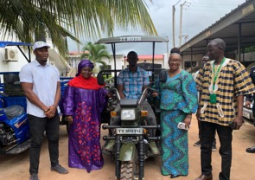Majority of handicraft artisans are small scale operators, who mostly derive their income from The Gambia's tourist industry.
To this end, they called on the government of the Gambia through the Ministry of Tourism and Culture to create better opportunities for those engaged in the domain.
The vendors, who were speaking in a recent exclusive with The Point newspaper, acknowledged that the sector is one area mostly dominated by youth, who use their unique and creative talents driven by a sense of culture and fashion.
Some of the items they deal in include, bead and jewellery, hats, woven baskets, key holders, traditional instruments for decorations, accessories, among others.
Haddy Joof, a vendor at the Senegambia Craft market, has been in the business for over 5 years, crafting and designing for fashion and decoration.
She, however, expressed some challenges confronting her business during the tourism offseason.
"The craft business is her only source of income in order to put food on the table for her family. However, the business usually takes a toll when the county’s tourism offseason calendar begins.
The uniqueness of a business, she added, helps it to blossom.
However, this is what serves as a challenge for Haddy as she believes her business is losing its unique values because of many people venturing into handicraft making.
Anonymous sources have said that Gambia has a fledgling handicrafts industry that includes artisans involved in the production of wood carving, batiks, tie-dye fabrics, dolls, dress and shirts, leather goods and cloth/rug weaving.
"With a few exceptions, the quality of these items is generally poor and there is need to expand the market".
The source added that the Ministry of Trade, Industry, and Employment (MoTIE) is the government institution that oversees the handicrafts sector. MoTIE monitors the industry through its Industrial Development Unit.
Meanwhile, women comprise a significant portion of handicraft artisans; they produce tie-dyed fabric that is used to make clothing and home accessories.
Few operate their own stalls at tourists’ markets as majority produce and sell directly to other vendors. Some handicraft artisans have received assistance in the past from the Government of The Gambia (GOTG) and international donors/NGOs.
For example, a rug and cloth weaving cooperative in Gambissara, Upper River District, has received assistance from the Indigenous Business Advisory Services (IBAS), a government agency which provides training, technical assistance and credit to small businesses, and from a Canadian NGO (CUSO) in the form of technical assistance and financial aid.
Training and technical assistance are viewed as an effective means to make needed changes and improvements within the industry. However, MoTIE is particularly concerned about the poor quality of handicrafts that are sold in The Gambia and would like to explore technological and production techniques that are employed in other countries experiencing success in producing and exporting handicraft items. USAID/Banjul is interested in assisting the GOTG to explore the potential for the expansion of the handicraft sector.
The Gambian Artisans Marketing Cooperative (GAMCO), a subsidiary of IBAS, was established in 1978 to market Gambian crafts. However, from the look of things, it appears to have suffered from an inability to adapt to changing market conditions as well as from the limitations of a government-funded agency engaged in the actual marketing of products produced




